Analysing Organisational Behaviour at Sainsbury's: A Detailed Report
VerifiedAdded on 2023/06/05
|14
|4232
|429
Report
AI Summary
This report provides an in-depth analysis of organisational behaviour within Sainsbury's, the second-largest supermarket chain in the UK. It examines the effects of organisational culture, politics, and power on individual and team behaviour and performance. Various theories of motivation, including Maslow's hierarchy of needs and Herzberg's two-factor theory, are discussed in relation to their impact on achieving organisational goals. The report highlights the key factors that differentiate effective teams from ineffective ones and applies organisational behaviour concepts and philosophies within the specific context of Sainsbury's business environment, considering both internal dynamics and external political influences. The analysis aims to provide insights into improving employee motivation, fostering a positive work environment, and enhancing overall organisational performance.
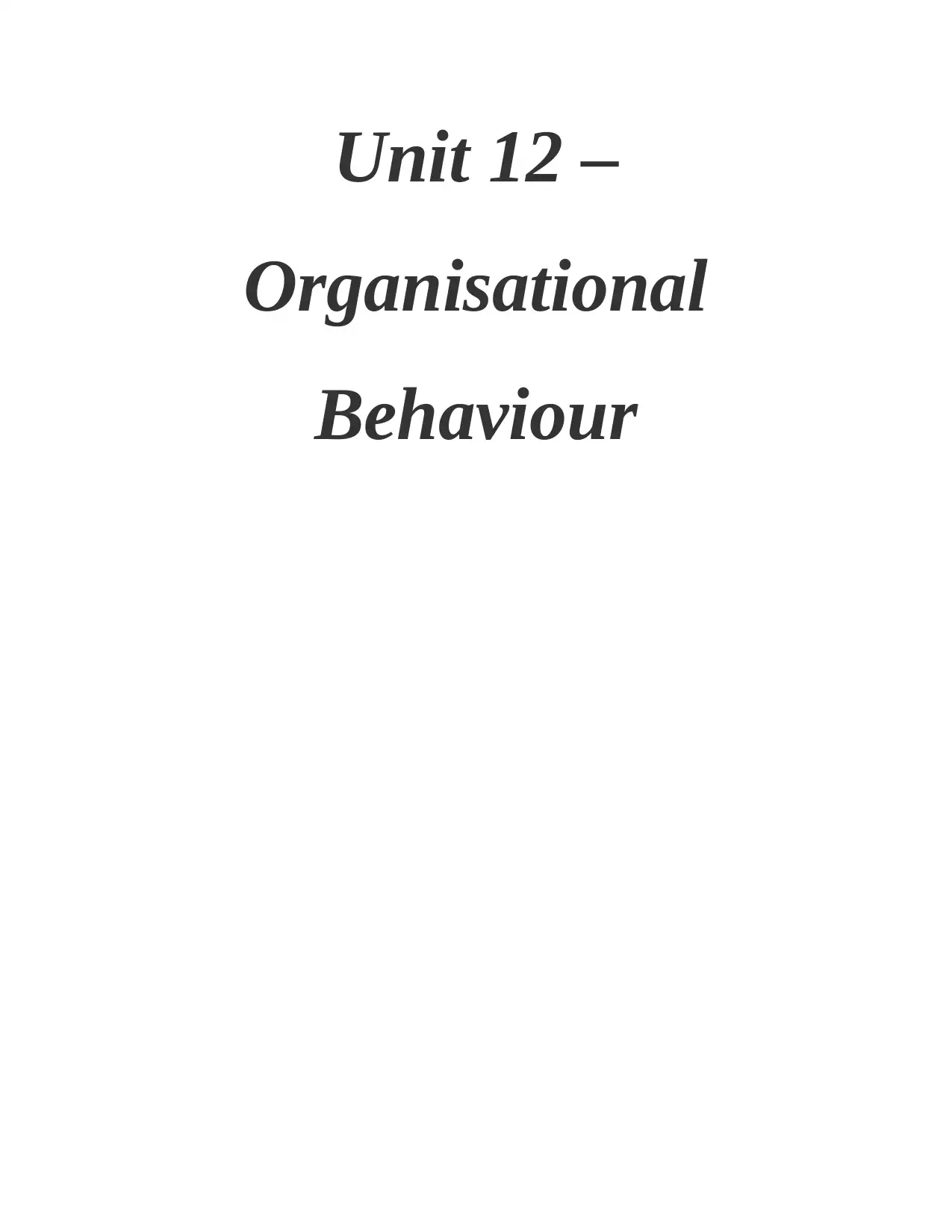
Unit 12 –
Organisational
Behaviour
Organisational
Behaviour
Secure Best Marks with AI Grader
Need help grading? Try our AI Grader for instant feedback on your assignments.
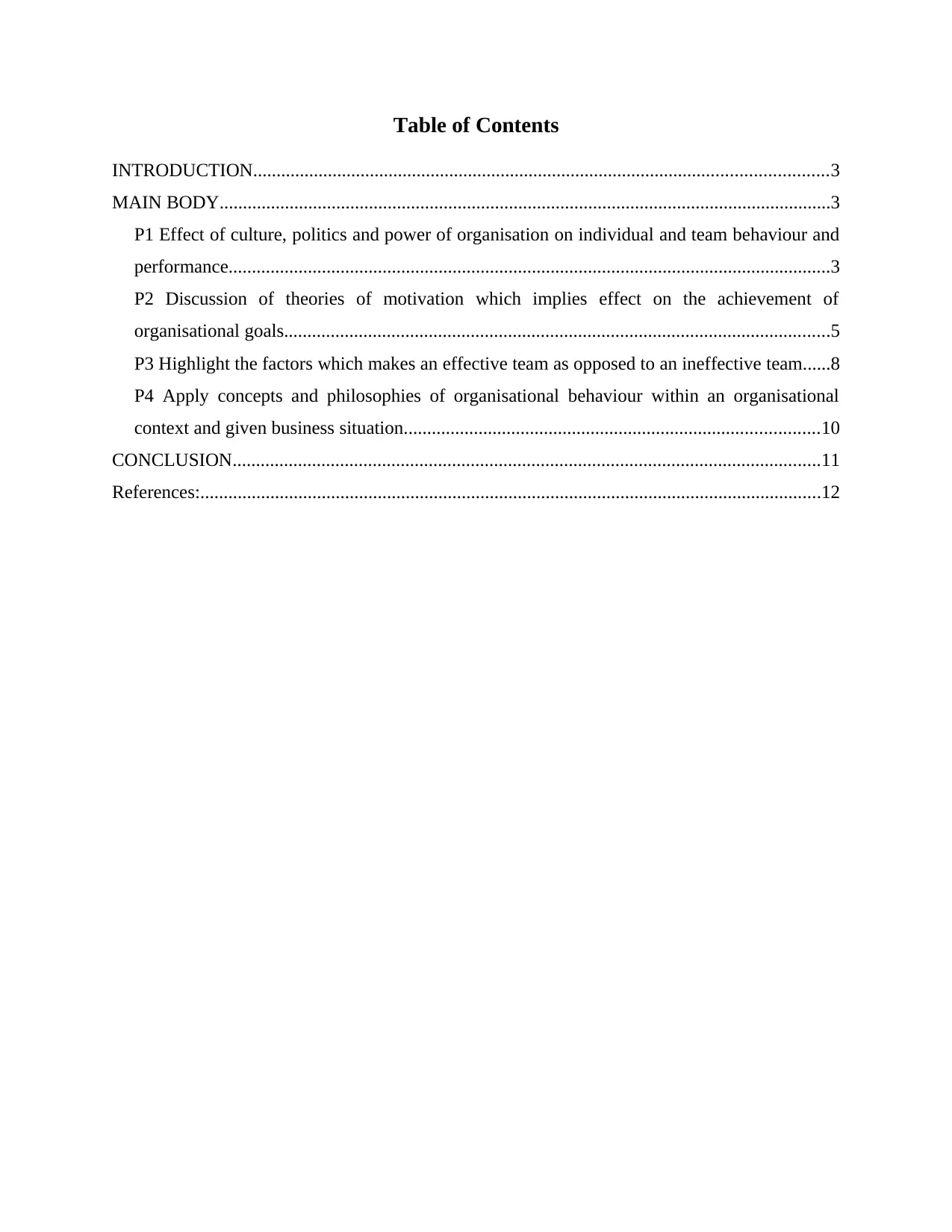
Table of Contents
INTRODUCTION...........................................................................................................................3
MAIN BODY...................................................................................................................................3
P1 Effect of culture, politics and power of organisation on individual and team behaviour and
performance.................................................................................................................................3
P2 Discussion of theories of motivation which implies effect on the achievement of
organisational goals.....................................................................................................................5
P3 Highlight the factors which makes an effective team as opposed to an ineffective team......8
P4 Apply concepts and philosophies of organisational behaviour within an organisational
context and given business situation.........................................................................................10
CONCLUSION..............................................................................................................................11
References:.....................................................................................................................................12
INTRODUCTION...........................................................................................................................3
MAIN BODY...................................................................................................................................3
P1 Effect of culture, politics and power of organisation on individual and team behaviour and
performance.................................................................................................................................3
P2 Discussion of theories of motivation which implies effect on the achievement of
organisational goals.....................................................................................................................5
P3 Highlight the factors which makes an effective team as opposed to an ineffective team......8
P4 Apply concepts and philosophies of organisational behaviour within an organisational
context and given business situation.........................................................................................10
CONCLUSION..............................................................................................................................11
References:.....................................................................................................................................12
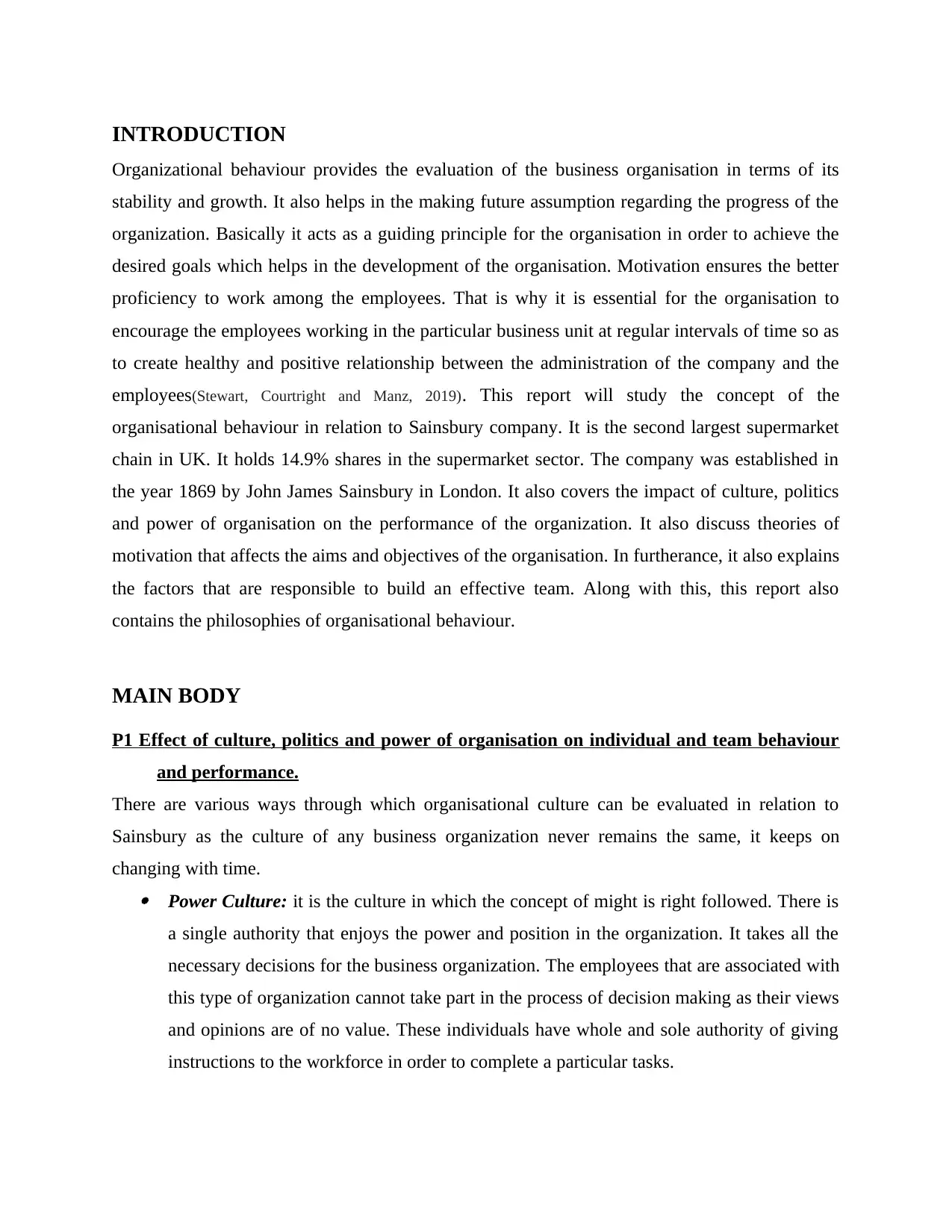
INTRODUCTION
Organizational behaviour provides the evaluation of the business organisation in terms of its
stability and growth. It also helps in the making future assumption regarding the progress of the
organization. Basically it acts as a guiding principle for the organisation in order to achieve the
desired goals which helps in the development of the organisation. Motivation ensures the better
proficiency to work among the employees. That is why it is essential for the organisation to
encourage the employees working in the particular business unit at regular intervals of time so as
to create healthy and positive relationship between the administration of the company and the
employees(Stewart, Courtright and Manz, 2019). This report will study the concept of the
organisational behaviour in relation to Sainsbury company. It is the second largest supermarket
chain in UK. It holds 14.9% shares in the supermarket sector. The company was established in
the year 1869 by John James Sainsbury in London. It also covers the impact of culture, politics
and power of organisation on the performance of the organization. It also discuss theories of
motivation that affects the aims and objectives of the organisation. In furtherance, it also explains
the factors that are responsible to build an effective team. Along with this, this report also
contains the philosophies of organisational behaviour.
MAIN BODY
P1 Effect of culture, politics and power of organisation on individual and team behaviour
and performance.
There are various ways through which organisational culture can be evaluated in relation to
Sainsbury as the culture of any business organization never remains the same, it keeps on
changing with time. Power Culture: it is the culture in which the concept of might is right followed. There is
a single authority that enjoys the power and position in the organization. It takes all the
necessary decisions for the business organization. The employees that are associated with
this type of organization cannot take part in the process of decision making as their views
and opinions are of no value. These individuals have whole and sole authority of giving
instructions to the workforce in order to complete a particular tasks.
Organizational behaviour provides the evaluation of the business organisation in terms of its
stability and growth. It also helps in the making future assumption regarding the progress of the
organization. Basically it acts as a guiding principle for the organisation in order to achieve the
desired goals which helps in the development of the organisation. Motivation ensures the better
proficiency to work among the employees. That is why it is essential for the organisation to
encourage the employees working in the particular business unit at regular intervals of time so as
to create healthy and positive relationship between the administration of the company and the
employees(Stewart, Courtright and Manz, 2019). This report will study the concept of the
organisational behaviour in relation to Sainsbury company. It is the second largest supermarket
chain in UK. It holds 14.9% shares in the supermarket sector. The company was established in
the year 1869 by John James Sainsbury in London. It also covers the impact of culture, politics
and power of organisation on the performance of the organization. It also discuss theories of
motivation that affects the aims and objectives of the organisation. In furtherance, it also explains
the factors that are responsible to build an effective team. Along with this, this report also
contains the philosophies of organisational behaviour.
MAIN BODY
P1 Effect of culture, politics and power of organisation on individual and team behaviour
and performance.
There are various ways through which organisational culture can be evaluated in relation to
Sainsbury as the culture of any business organization never remains the same, it keeps on
changing with time. Power Culture: it is the culture in which the concept of might is right followed. There is
a single authority that enjoys the power and position in the organization. It takes all the
necessary decisions for the business organization. The employees that are associated with
this type of organization cannot take part in the process of decision making as their views
and opinions are of no value. These individuals have whole and sole authority of giving
instructions to the workforce in order to complete a particular tasks.
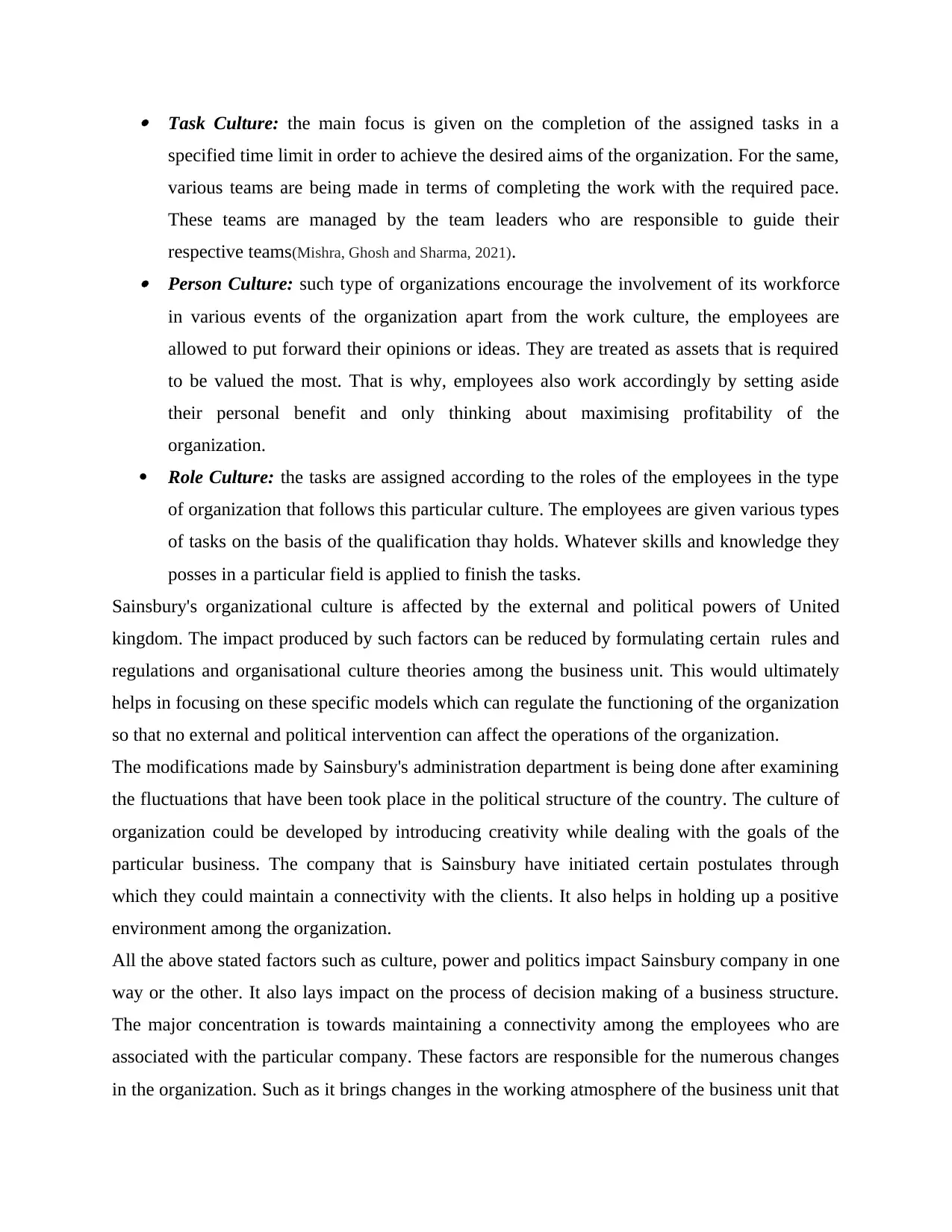
Task Culture: the main focus is given on the completion of the assigned tasks in a
specified time limit in order to achieve the desired aims of the organization. For the same,
various teams are being made in terms of completing the work with the required pace.
These teams are managed by the team leaders who are responsible to guide their
respective teams(Mishra, Ghosh and Sharma, 2021). Person Culture: such type of organizations encourage the involvement of its workforce
in various events of the organization apart from the work culture, the employees are
allowed to put forward their opinions or ideas. They are treated as assets that is required
to be valued the most. That is why, employees also work accordingly by setting aside
their personal benefit and only thinking about maximising profitability of the
organization.
Role Culture: the tasks are assigned according to the roles of the employees in the type
of organization that follows this particular culture. The employees are given various types
of tasks on the basis of the qualification thay holds. Whatever skills and knowledge they
posses in a particular field is applied to finish the tasks.
Sainsbury's organizational culture is affected by the external and political powers of United
kingdom. The impact produced by such factors can be reduced by formulating certain rules and
regulations and organisational culture theories among the business unit. This would ultimately
helps in focusing on these specific models which can regulate the functioning of the organization
so that no external and political intervention can affect the operations of the organization.
The modifications made by Sainsbury's administration department is being done after examining
the fluctuations that have been took place in the political structure of the country. The culture of
organization could be developed by introducing creativity while dealing with the goals of the
particular business. The company that is Sainsbury have initiated certain postulates through
which they could maintain a connectivity with the clients. It also helps in holding up a positive
environment among the organization.
All the above stated factors such as culture, power and politics impact Sainsbury company in one
way or the other. It also lays impact on the process of decision making of a business structure.
The major concentration is towards maintaining a connectivity among the employees who are
associated with the particular company. These factors are responsible for the numerous changes
in the organization. Such as it brings changes in the working atmosphere of the business unit that
specified time limit in order to achieve the desired aims of the organization. For the same,
various teams are being made in terms of completing the work with the required pace.
These teams are managed by the team leaders who are responsible to guide their
respective teams(Mishra, Ghosh and Sharma, 2021). Person Culture: such type of organizations encourage the involvement of its workforce
in various events of the organization apart from the work culture, the employees are
allowed to put forward their opinions or ideas. They are treated as assets that is required
to be valued the most. That is why, employees also work accordingly by setting aside
their personal benefit and only thinking about maximising profitability of the
organization.
Role Culture: the tasks are assigned according to the roles of the employees in the type
of organization that follows this particular culture. The employees are given various types
of tasks on the basis of the qualification thay holds. Whatever skills and knowledge they
posses in a particular field is applied to finish the tasks.
Sainsbury's organizational culture is affected by the external and political powers of United
kingdom. The impact produced by such factors can be reduced by formulating certain rules and
regulations and organisational culture theories among the business unit. This would ultimately
helps in focusing on these specific models which can regulate the functioning of the organization
so that no external and political intervention can affect the operations of the organization.
The modifications made by Sainsbury's administration department is being done after examining
the fluctuations that have been took place in the political structure of the country. The culture of
organization could be developed by introducing creativity while dealing with the goals of the
particular business. The company that is Sainsbury have initiated certain postulates through
which they could maintain a connectivity with the clients. It also helps in holding up a positive
environment among the organization.
All the above stated factors such as culture, power and politics impact Sainsbury company in one
way or the other. It also lays impact on the process of decision making of a business structure.
The major concentration is towards maintaining a connectivity among the employees who are
associated with the particular company. These factors are responsible for the numerous changes
in the organization. Such as it brings changes in the working atmosphere of the business unit that
Secure Best Marks with AI Grader
Need help grading? Try our AI Grader for instant feedback on your assignments.
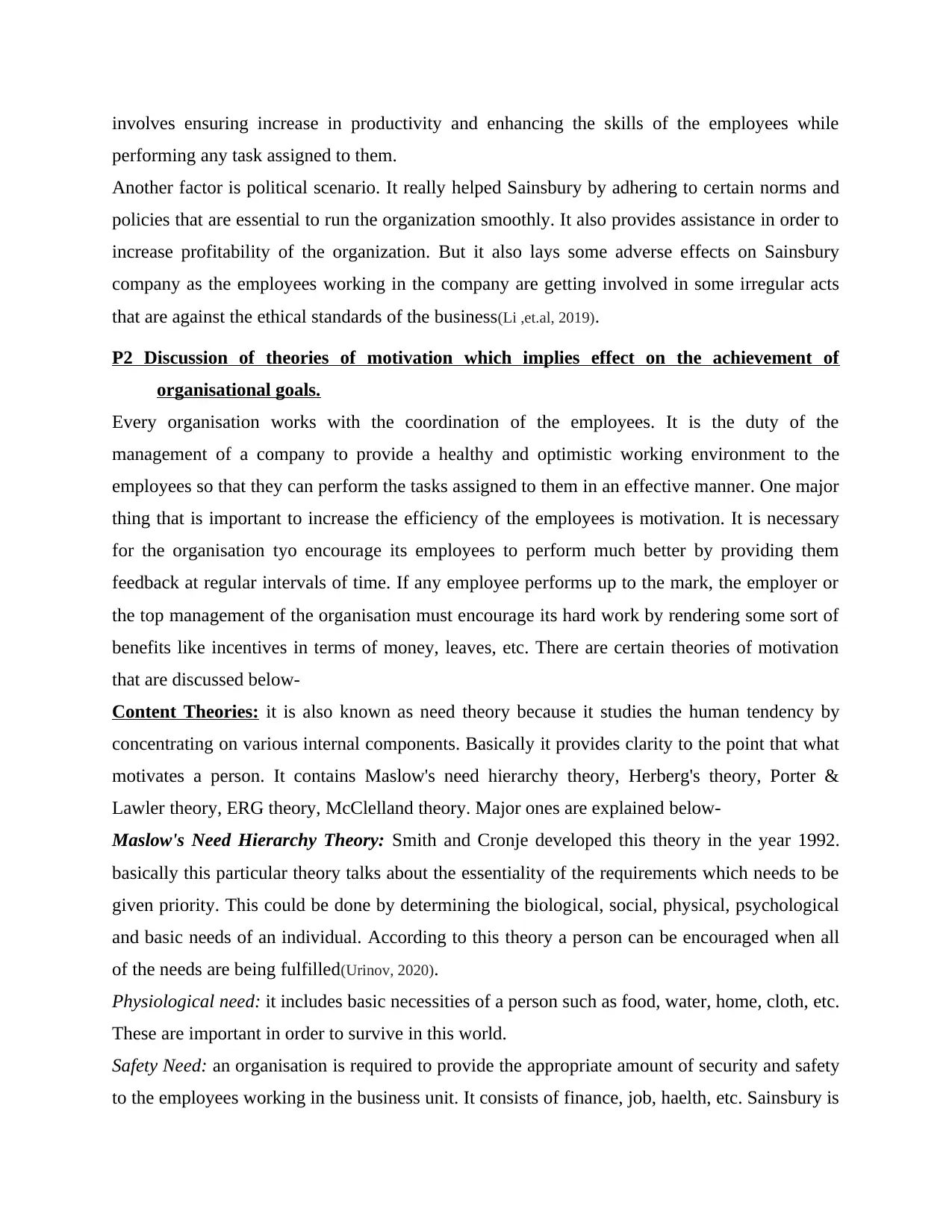
involves ensuring increase in productivity and enhancing the skills of the employees while
performing any task assigned to them.
Another factor is political scenario. It really helped Sainsbury by adhering to certain norms and
policies that are essential to run the organization smoothly. It also provides assistance in order to
increase profitability of the organization. But it also lays some adverse effects on Sainsbury
company as the employees working in the company are getting involved in some irregular acts
that are against the ethical standards of the business(Li ,et.al, 2019).
P2 Discussion of theories of motivation which implies effect on the achievement of
organisational goals.
Every organisation works with the coordination of the employees. It is the duty of the
management of a company to provide a healthy and optimistic working environment to the
employees so that they can perform the tasks assigned to them in an effective manner. One major
thing that is important to increase the efficiency of the employees is motivation. It is necessary
for the organisation tyo encourage its employees to perform much better by providing them
feedback at regular intervals of time. If any employee performs up to the mark, the employer or
the top management of the organisation must encourage its hard work by rendering some sort of
benefits like incentives in terms of money, leaves, etc. There are certain theories of motivation
that are discussed below-
Content Theories: it is also known as need theory because it studies the human tendency by
concentrating on various internal components. Basically it provides clarity to the point that what
motivates a person. It contains Maslow's need hierarchy theory, Herberg's theory, Porter &
Lawler theory, ERG theory, McClelland theory. Major ones are explained below-
Maslow's Need Hierarchy Theory: Smith and Cronje developed this theory in the year 1992.
basically this particular theory talks about the essentiality of the requirements which needs to be
given priority. This could be done by determining the biological, social, physical, psychological
and basic needs of an individual. According to this theory a person can be encouraged when all
of the needs are being fulfilled(Urinov, 2020).
Physiological need: it includes basic necessities of a person such as food, water, home, cloth, etc.
These are important in order to survive in this world.
Safety Need: an organisation is required to provide the appropriate amount of security and safety
to the employees working in the business unit. It consists of finance, job, haelth, etc. Sainsbury is
performing any task assigned to them.
Another factor is political scenario. It really helped Sainsbury by adhering to certain norms and
policies that are essential to run the organization smoothly. It also provides assistance in order to
increase profitability of the organization. But it also lays some adverse effects on Sainsbury
company as the employees working in the company are getting involved in some irregular acts
that are against the ethical standards of the business(Li ,et.al, 2019).
P2 Discussion of theories of motivation which implies effect on the achievement of
organisational goals.
Every organisation works with the coordination of the employees. It is the duty of the
management of a company to provide a healthy and optimistic working environment to the
employees so that they can perform the tasks assigned to them in an effective manner. One major
thing that is important to increase the efficiency of the employees is motivation. It is necessary
for the organisation tyo encourage its employees to perform much better by providing them
feedback at regular intervals of time. If any employee performs up to the mark, the employer or
the top management of the organisation must encourage its hard work by rendering some sort of
benefits like incentives in terms of money, leaves, etc. There are certain theories of motivation
that are discussed below-
Content Theories: it is also known as need theory because it studies the human tendency by
concentrating on various internal components. Basically it provides clarity to the point that what
motivates a person. It contains Maslow's need hierarchy theory, Herberg's theory, Porter &
Lawler theory, ERG theory, McClelland theory. Major ones are explained below-
Maslow's Need Hierarchy Theory: Smith and Cronje developed this theory in the year 1992.
basically this particular theory talks about the essentiality of the requirements which needs to be
given priority. This could be done by determining the biological, social, physical, psychological
and basic needs of an individual. According to this theory a person can be encouraged when all
of the needs are being fulfilled(Urinov, 2020).
Physiological need: it includes basic necessities of a person such as food, water, home, cloth, etc.
These are important in order to survive in this world.
Safety Need: an organisation is required to provide the appropriate amount of security and safety
to the employees working in the business unit. It consists of finance, job, haelth, etc. Sainsbury is
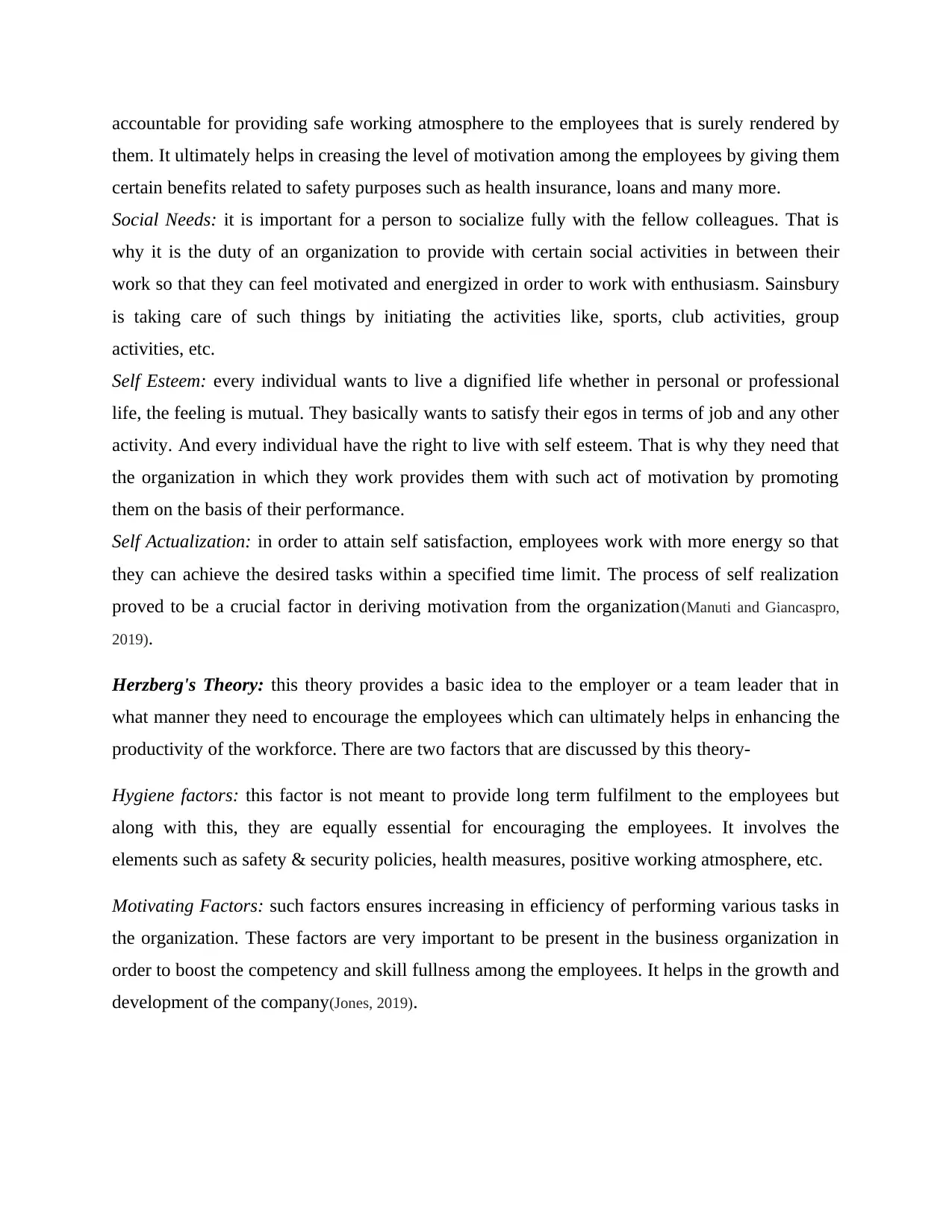
accountable for providing safe working atmosphere to the employees that is surely rendered by
them. It ultimately helps in creasing the level of motivation among the employees by giving them
certain benefits related to safety purposes such as health insurance, loans and many more.
Social Needs: it is important for a person to socialize fully with the fellow colleagues. That is
why it is the duty of an organization to provide with certain social activities in between their
work so that they can feel motivated and energized in order to work with enthusiasm. Sainsbury
is taking care of such things by initiating the activities like, sports, club activities, group
activities, etc.
Self Esteem: every individual wants to live a dignified life whether in personal or professional
life, the feeling is mutual. They basically wants to satisfy their egos in terms of job and any other
activity. And every individual have the right to live with self esteem. That is why they need that
the organization in which they work provides them with such act of motivation by promoting
them on the basis of their performance.
Self Actualization: in order to attain self satisfaction, employees work with more energy so that
they can achieve the desired tasks within a specified time limit. The process of self realization
proved to be a crucial factor in deriving motivation from the organization(Manuti and Giancaspro,
2019).
Herzberg's Theory: this theory provides a basic idea to the employer or a team leader that in
what manner they need to encourage the employees which can ultimately helps in enhancing the
productivity of the workforce. There are two factors that are discussed by this theory-
Hygiene factors: this factor is not meant to provide long term fulfilment to the employees but
along with this, they are equally essential for encouraging the employees. It involves the
elements such as safety & security policies, health measures, positive working atmosphere, etc.
Motivating Factors: such factors ensures increasing in efficiency of performing various tasks in
the organization. These factors are very important to be present in the business organization in
order to boost the competency and skill fullness among the employees. It helps in the growth and
development of the company(Jones, 2019).
them. It ultimately helps in creasing the level of motivation among the employees by giving them
certain benefits related to safety purposes such as health insurance, loans and many more.
Social Needs: it is important for a person to socialize fully with the fellow colleagues. That is
why it is the duty of an organization to provide with certain social activities in between their
work so that they can feel motivated and energized in order to work with enthusiasm. Sainsbury
is taking care of such things by initiating the activities like, sports, club activities, group
activities, etc.
Self Esteem: every individual wants to live a dignified life whether in personal or professional
life, the feeling is mutual. They basically wants to satisfy their egos in terms of job and any other
activity. And every individual have the right to live with self esteem. That is why they need that
the organization in which they work provides them with such act of motivation by promoting
them on the basis of their performance.
Self Actualization: in order to attain self satisfaction, employees work with more energy so that
they can achieve the desired tasks within a specified time limit. The process of self realization
proved to be a crucial factor in deriving motivation from the organization(Manuti and Giancaspro,
2019).
Herzberg's Theory: this theory provides a basic idea to the employer or a team leader that in
what manner they need to encourage the employees which can ultimately helps in enhancing the
productivity of the workforce. There are two factors that are discussed by this theory-
Hygiene factors: this factor is not meant to provide long term fulfilment to the employees but
along with this, they are equally essential for encouraging the employees. It involves the
elements such as safety & security policies, health measures, positive working atmosphere, etc.
Motivating Factors: such factors ensures increasing in efficiency of performing various tasks in
the organization. These factors are very important to be present in the business organization in
order to boost the competency and skill fullness among the employees. It helps in the growth and
development of the company(Jones, 2019).
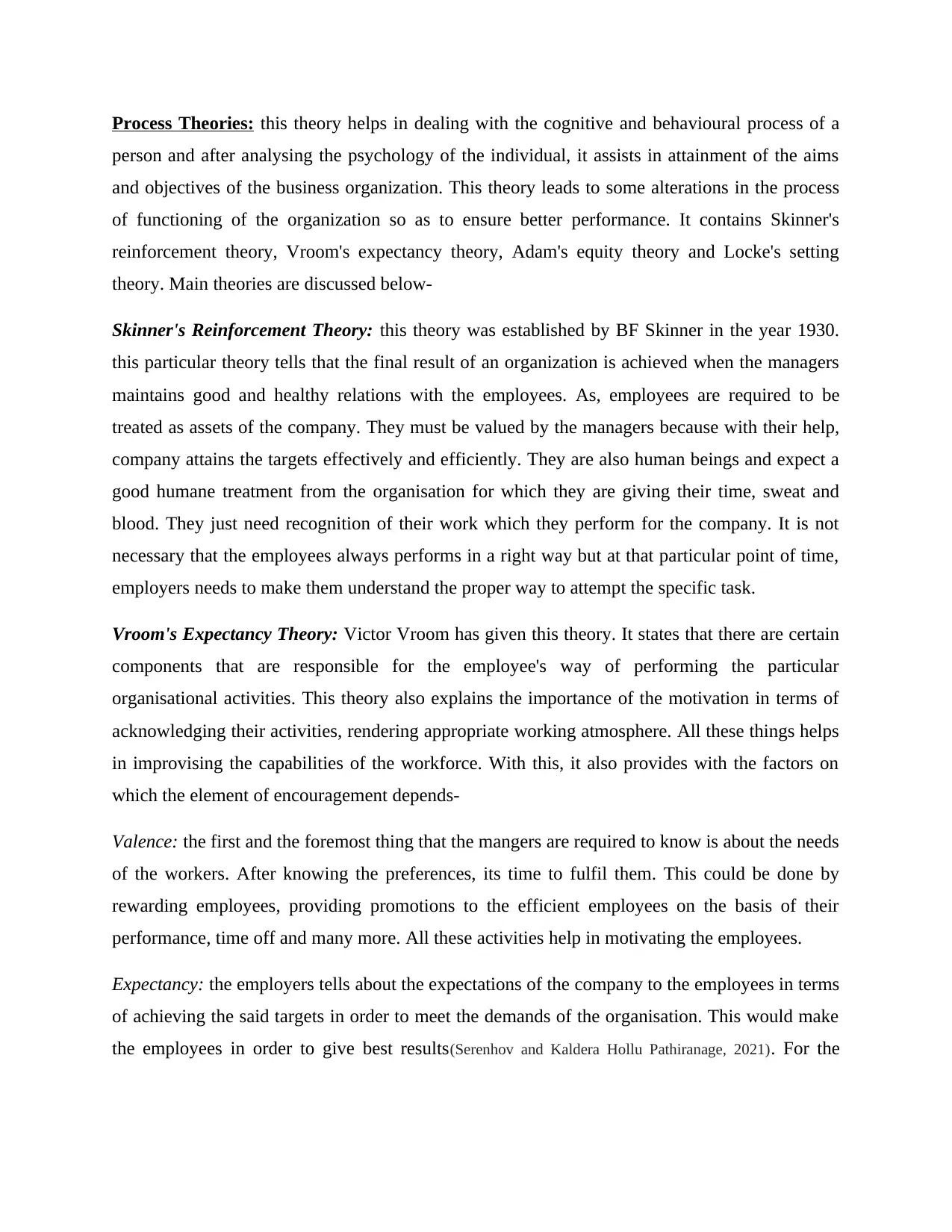
Process Theories: this theory helps in dealing with the cognitive and behavioural process of a
person and after analysing the psychology of the individual, it assists in attainment of the aims
and objectives of the business organization. This theory leads to some alterations in the process
of functioning of the organization so as to ensure better performance. It contains Skinner's
reinforcement theory, Vroom's expectancy theory, Adam's equity theory and Locke's setting
theory. Main theories are discussed below-
Skinner's Reinforcement Theory: this theory was established by BF Skinner in the year 1930.
this particular theory tells that the final result of an organization is achieved when the managers
maintains good and healthy relations with the employees. As, employees are required to be
treated as assets of the company. They must be valued by the managers because with their help,
company attains the targets effectively and efficiently. They are also human beings and expect a
good humane treatment from the organisation for which they are giving their time, sweat and
blood. They just need recognition of their work which they perform for the company. It is not
necessary that the employees always performs in a right way but at that particular point of time,
employers needs to make them understand the proper way to attempt the specific task.
Vroom's Expectancy Theory: Victor Vroom has given this theory. It states that there are certain
components that are responsible for the employee's way of performing the particular
organisational activities. This theory also explains the importance of the motivation in terms of
acknowledging their activities, rendering appropriate working atmosphere. All these things helps
in improvising the capabilities of the workforce. With this, it also provides with the factors on
which the element of encouragement depends-
Valence: the first and the foremost thing that the mangers are required to know is about the needs
of the workers. After knowing the preferences, its time to fulfil them. This could be done by
rewarding employees, providing promotions to the efficient employees on the basis of their
performance, time off and many more. All these activities help in motivating the employees.
Expectancy: the employers tells about the expectations of the company to the employees in terms
of achieving the said targets in order to meet the demands of the organisation. This would make
the employees in order to give best results(Serenhov and Kaldera Hollu Pathiranage, 2021). For the
person and after analysing the psychology of the individual, it assists in attainment of the aims
and objectives of the business organization. This theory leads to some alterations in the process
of functioning of the organization so as to ensure better performance. It contains Skinner's
reinforcement theory, Vroom's expectancy theory, Adam's equity theory and Locke's setting
theory. Main theories are discussed below-
Skinner's Reinforcement Theory: this theory was established by BF Skinner in the year 1930.
this particular theory tells that the final result of an organization is achieved when the managers
maintains good and healthy relations with the employees. As, employees are required to be
treated as assets of the company. They must be valued by the managers because with their help,
company attains the targets effectively and efficiently. They are also human beings and expect a
good humane treatment from the organisation for which they are giving their time, sweat and
blood. They just need recognition of their work which they perform for the company. It is not
necessary that the employees always performs in a right way but at that particular point of time,
employers needs to make them understand the proper way to attempt the specific task.
Vroom's Expectancy Theory: Victor Vroom has given this theory. It states that there are certain
components that are responsible for the employee's way of performing the particular
organisational activities. This theory also explains the importance of the motivation in terms of
acknowledging their activities, rendering appropriate working atmosphere. All these things helps
in improvising the capabilities of the workforce. With this, it also provides with the factors on
which the element of encouragement depends-
Valence: the first and the foremost thing that the mangers are required to know is about the needs
of the workers. After knowing the preferences, its time to fulfil them. This could be done by
rewarding employees, providing promotions to the efficient employees on the basis of their
performance, time off and many more. All these activities help in motivating the employees.
Expectancy: the employers tells about the expectations of the company to the employees in terms
of achieving the said targets in order to meet the demands of the organisation. This would make
the employees in order to give best results(Serenhov and Kaldera Hollu Pathiranage, 2021). For the
Paraphrase This Document
Need a fresh take? Get an instant paraphrase of this document with our AI Paraphraser
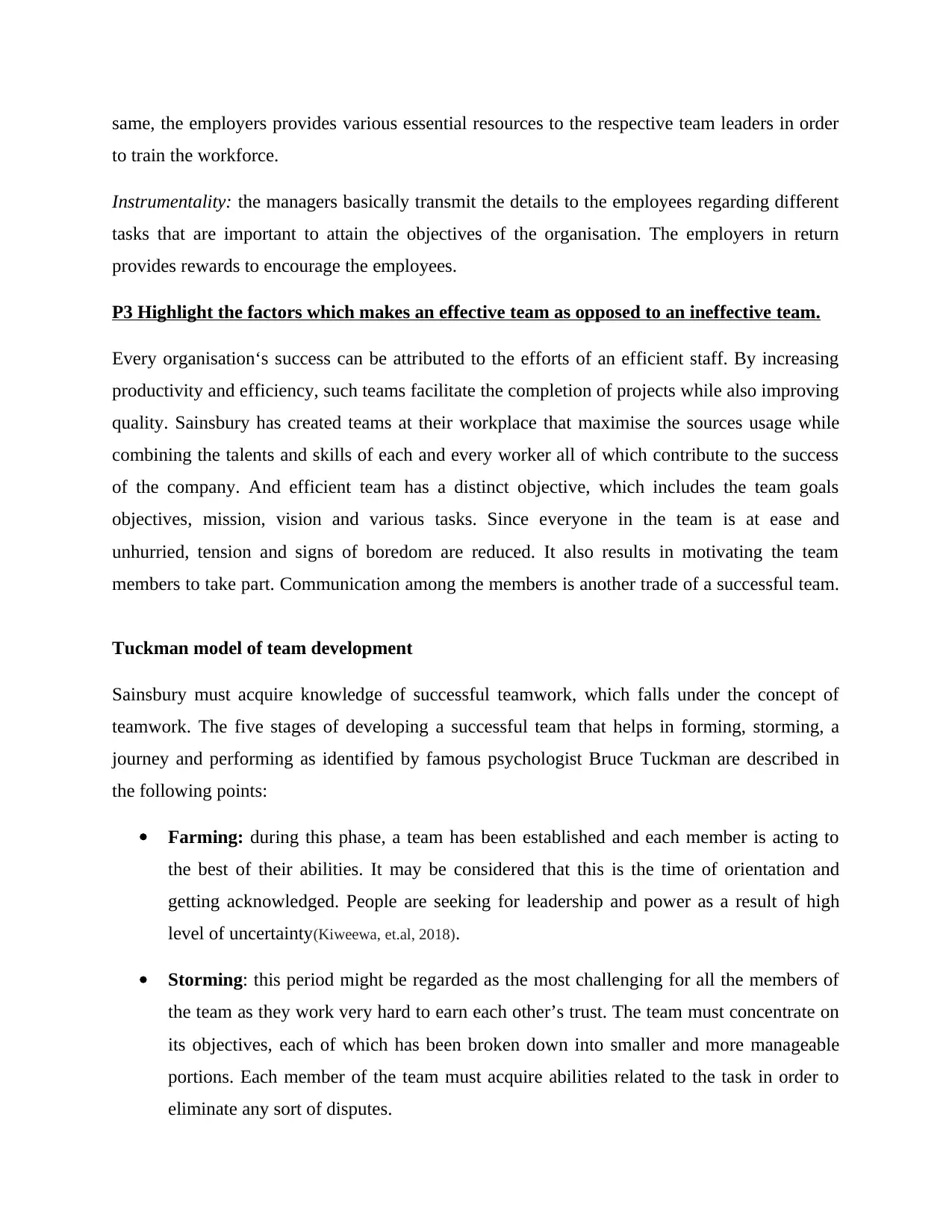
same, the employers provides various essential resources to the respective team leaders in order
to train the workforce.
Instrumentality: the managers basically transmit the details to the employees regarding different
tasks that are important to attain the objectives of the organisation. The employers in return
provides rewards to encourage the employees.
P3 Highlight the factors which makes an effective team as opposed to an ineffective team.
Every organisation‘s success can be attributed to the efforts of an efficient staff. By increasing
productivity and efficiency, such teams facilitate the completion of projects while also improving
quality. Sainsbury has created teams at their workplace that maximise the sources usage while
combining the talents and skills of each and every worker all of which contribute to the success
of the company. And efficient team has a distinct objective, which includes the team goals
objectives, mission, vision and various tasks. Since everyone in the team is at ease and
unhurried, tension and signs of boredom are reduced. It also results in motivating the team
members to take part. Communication among the members is another trade of a successful team.
Tuckman model of team development
Sainsbury must acquire knowledge of successful teamwork, which falls under the concept of
teamwork. The five stages of developing a successful team that helps in forming, storming, a
journey and performing as identified by famous psychologist Bruce Tuckman are described in
the following points:
Farming: during this phase, a team has been established and each member is acting to
the best of their abilities. It may be considered that this is the time of orientation and
getting acknowledged. People are seeking for leadership and power as a result of high
level of uncertainty(Kiweewa, et.al, 2018).
Storming: this period might be regarded as the most challenging for all the members of
the team as they work very hard to earn each other’s trust. The team must concentrate on
its objectives, each of which has been broken down into smaller and more manageable
portions. Each member of the team must acquire abilities related to the task in order to
eliminate any sort of disputes.
to train the workforce.
Instrumentality: the managers basically transmit the details to the employees regarding different
tasks that are important to attain the objectives of the organisation. The employers in return
provides rewards to encourage the employees.
P3 Highlight the factors which makes an effective team as opposed to an ineffective team.
Every organisation‘s success can be attributed to the efforts of an efficient staff. By increasing
productivity and efficiency, such teams facilitate the completion of projects while also improving
quality. Sainsbury has created teams at their workplace that maximise the sources usage while
combining the talents and skills of each and every worker all of which contribute to the success
of the company. And efficient team has a distinct objective, which includes the team goals
objectives, mission, vision and various tasks. Since everyone in the team is at ease and
unhurried, tension and signs of boredom are reduced. It also results in motivating the team
members to take part. Communication among the members is another trade of a successful team.
Tuckman model of team development
Sainsbury must acquire knowledge of successful teamwork, which falls under the concept of
teamwork. The five stages of developing a successful team that helps in forming, storming, a
journey and performing as identified by famous psychologist Bruce Tuckman are described in
the following points:
Farming: during this phase, a team has been established and each member is acting to
the best of their abilities. It may be considered that this is the time of orientation and
getting acknowledged. People are seeking for leadership and power as a result of high
level of uncertainty(Kiweewa, et.al, 2018).
Storming: this period might be regarded as the most challenging for all the members of
the team as they work very hard to earn each other’s trust. The team must concentrate on
its objectives, each of which has been broken down into smaller and more manageable
portions. Each member of the team must acquire abilities related to the task in order to
eliminate any sort of disputes.
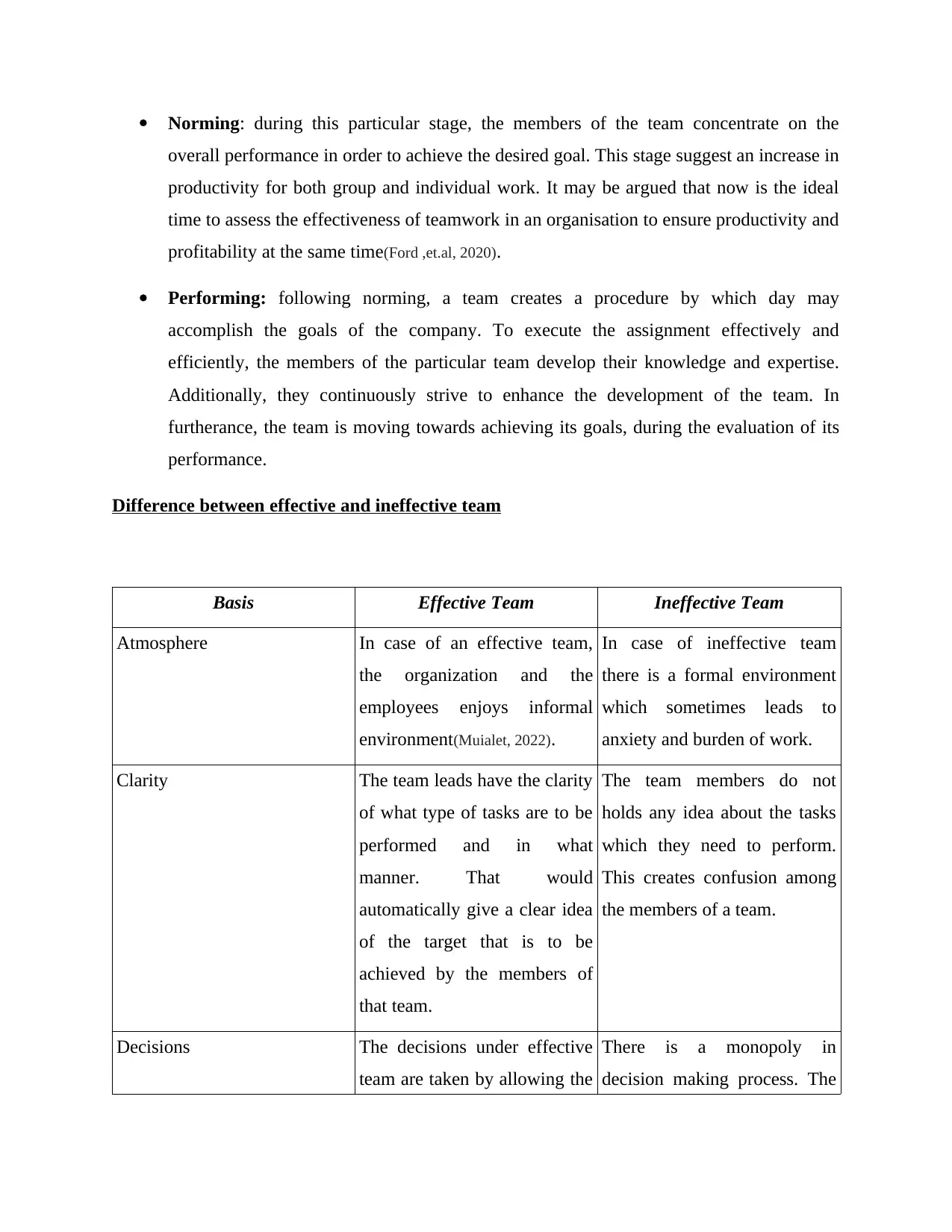
Norming: during this particular stage, the members of the team concentrate on the
overall performance in order to achieve the desired goal. This stage suggest an increase in
productivity for both group and individual work. It may be argued that now is the ideal
time to assess the effectiveness of teamwork in an organisation to ensure productivity and
profitability at the same time(Ford ,et.al, 2020).
Performing: following norming, a team creates a procedure by which day may
accomplish the goals of the company. To execute the assignment effectively and
efficiently, the members of the particular team develop their knowledge and expertise.
Additionally, they continuously strive to enhance the development of the team. In
furtherance, the team is moving towards achieving its goals, during the evaluation of its
performance.
Difference between effective and ineffective team
Basis Effective Team Ineffective Team
Atmosphere In case of an effective team,
the organization and the
employees enjoys informal
environment(Muialet, 2022).
In case of ineffective team
there is a formal environment
which sometimes leads to
anxiety and burden of work.
Clarity The team leads have the clarity
of what type of tasks are to be
performed and in what
manner. That would
automatically give a clear idea
of the target that is to be
achieved by the members of
that team.
The team members do not
holds any idea about the tasks
which they need to perform.
This creates confusion among
the members of a team.
Decisions The decisions under effective
team are taken by allowing the
There is a monopoly in
decision making process. The
overall performance in order to achieve the desired goal. This stage suggest an increase in
productivity for both group and individual work. It may be argued that now is the ideal
time to assess the effectiveness of teamwork in an organisation to ensure productivity and
profitability at the same time(Ford ,et.al, 2020).
Performing: following norming, a team creates a procedure by which day may
accomplish the goals of the company. To execute the assignment effectively and
efficiently, the members of the particular team develop their knowledge and expertise.
Additionally, they continuously strive to enhance the development of the team. In
furtherance, the team is moving towards achieving its goals, during the evaluation of its
performance.
Difference between effective and ineffective team
Basis Effective Team Ineffective Team
Atmosphere In case of an effective team,
the organization and the
employees enjoys informal
environment(Muialet, 2022).
In case of ineffective team
there is a formal environment
which sometimes leads to
anxiety and burden of work.
Clarity The team leads have the clarity
of what type of tasks are to be
performed and in what
manner. That would
automatically give a clear idea
of the target that is to be
achieved by the members of
that team.
The team members do not
holds any idea about the tasks
which they need to perform.
This creates confusion among
the members of a team.
Decisions The decisions under effective
team are taken by allowing the
There is a monopoly in
decision making process. The
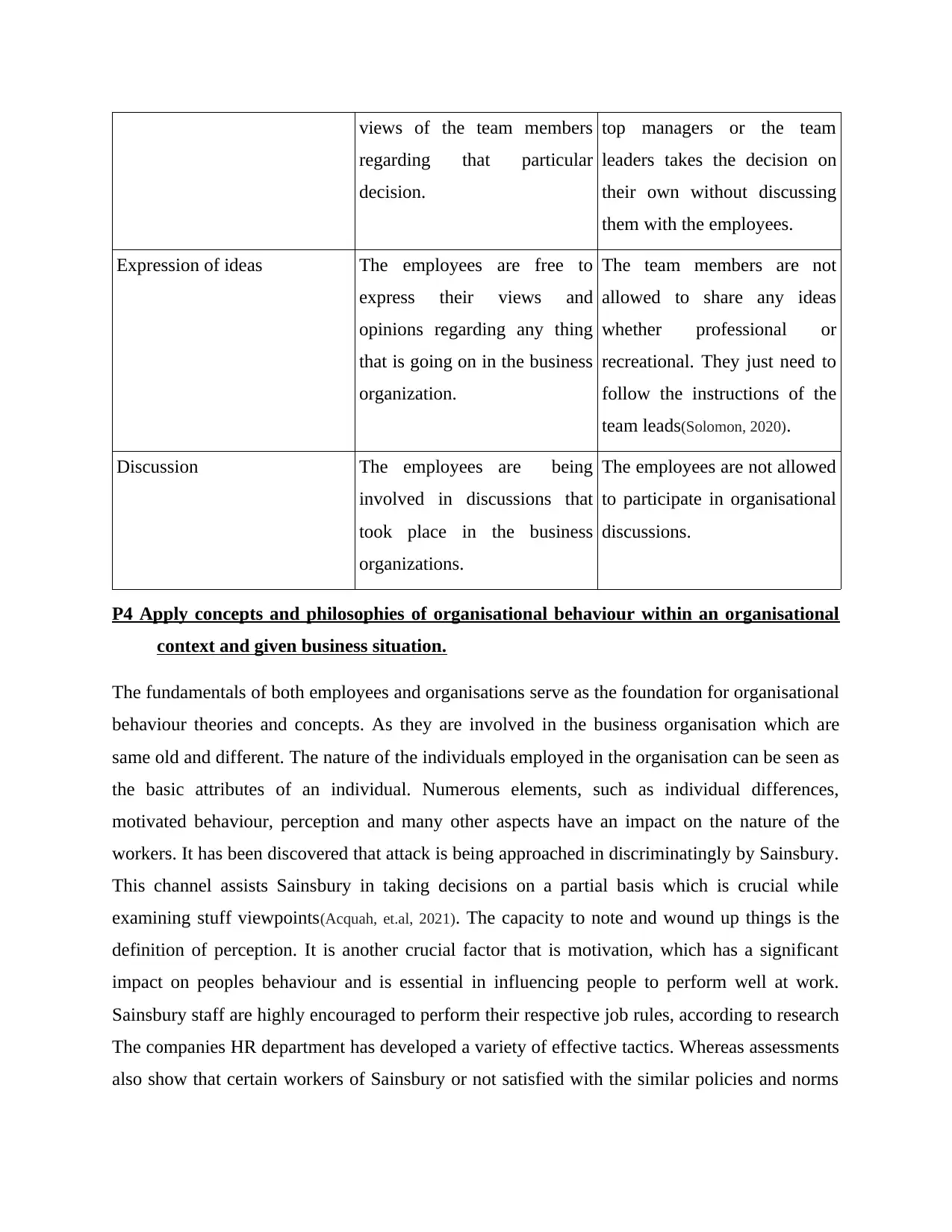
views of the team members
regarding that particular
decision.
top managers or the team
leaders takes the decision on
their own without discussing
them with the employees.
Expression of ideas The employees are free to
express their views and
opinions regarding any thing
that is going on in the business
organization.
The team members are not
allowed to share any ideas
whether professional or
recreational. They just need to
follow the instructions of the
team leads(Solomon, 2020).
Discussion The employees are being
involved in discussions that
took place in the business
organizations.
The employees are not allowed
to participate in organisational
discussions.
P4 Apply concepts and philosophies of organisational behaviour within an organisational
context and given business situation.
The fundamentals of both employees and organisations serve as the foundation for organisational
behaviour theories and concepts. As they are involved in the business organisation which are
same old and different. The nature of the individuals employed in the organisation can be seen as
the basic attributes of an individual. Numerous elements, such as individual differences,
motivated behaviour, perception and many other aspects have an impact on the nature of the
workers. It has been discovered that attack is being approached in discriminatingly by Sainsbury.
This channel assists Sainsbury in taking decisions on a partial basis which is crucial while
examining stuff viewpoints(Acquah, et.al, 2021). The capacity to note and wound up things is the
definition of perception. It is another crucial factor that is motivation, which has a significant
impact on peoples behaviour and is essential in influencing people to perform well at work.
Sainsbury staff are highly encouraged to perform their respective job rules, according to research
The companies HR department has developed a variety of effective tactics. Whereas assessments
also show that certain workers of Sainsbury or not satisfied with the similar policies and norms
regarding that particular
decision.
top managers or the team
leaders takes the decision on
their own without discussing
them with the employees.
Expression of ideas The employees are free to
express their views and
opinions regarding any thing
that is going on in the business
organization.
The team members are not
allowed to share any ideas
whether professional or
recreational. They just need to
follow the instructions of the
team leads(Solomon, 2020).
Discussion The employees are being
involved in discussions that
took place in the business
organizations.
The employees are not allowed
to participate in organisational
discussions.
P4 Apply concepts and philosophies of organisational behaviour within an organisational
context and given business situation.
The fundamentals of both employees and organisations serve as the foundation for organisational
behaviour theories and concepts. As they are involved in the business organisation which are
same old and different. The nature of the individuals employed in the organisation can be seen as
the basic attributes of an individual. Numerous elements, such as individual differences,
motivated behaviour, perception and many other aspects have an impact on the nature of the
workers. It has been discovered that attack is being approached in discriminatingly by Sainsbury.
This channel assists Sainsbury in taking decisions on a partial basis which is crucial while
examining stuff viewpoints(Acquah, et.al, 2021). The capacity to note and wound up things is the
definition of perception. It is another crucial factor that is motivation, which has a significant
impact on peoples behaviour and is essential in influencing people to perform well at work.
Sainsbury staff are highly encouraged to perform their respective job rules, according to research
The companies HR department has developed a variety of effective tactics. Whereas assessments
also show that certain workers of Sainsbury or not satisfied with the similar policies and norms
Secure Best Marks with AI Grader
Need help grading? Try our AI Grader for instant feedback on your assignments.
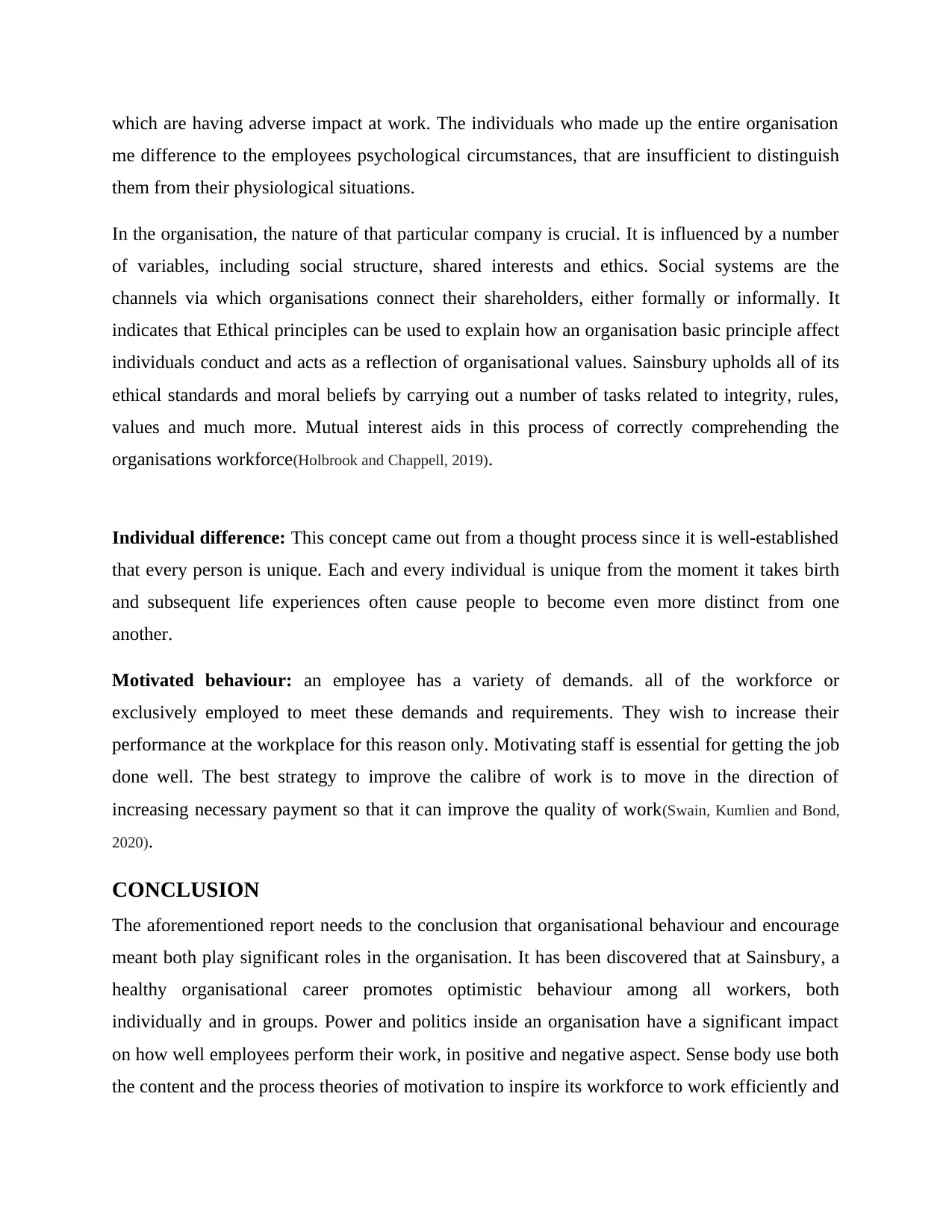
which are having adverse impact at work. The individuals who made up the entire organisation
me difference to the employees psychological circumstances, that are insufficient to distinguish
them from their physiological situations.
In the organisation, the nature of that particular company is crucial. It is influenced by a number
of variables, including social structure, shared interests and ethics. Social systems are the
channels via which organisations connect their shareholders, either formally or informally. It
indicates that Ethical principles can be used to explain how an organisation basic principle affect
individuals conduct and acts as a reflection of organisational values. Sainsbury upholds all of its
ethical standards and moral beliefs by carrying out a number of tasks related to integrity, rules,
values and much more. Mutual interest aids in this process of correctly comprehending the
organisations workforce(Holbrook and Chappell, 2019).
Individual difference: This concept came out from a thought process since it is well-established
that every person is unique. Each and every individual is unique from the moment it takes birth
and subsequent life experiences often cause people to become even more distinct from one
another.
Motivated behaviour: an employee has a variety of demands. all of the workforce or
exclusively employed to meet these demands and requirements. They wish to increase their
performance at the workplace for this reason only. Motivating staff is essential for getting the job
done well. The best strategy to improve the calibre of work is to move in the direction of
increasing necessary payment so that it can improve the quality of work(Swain, Kumlien and Bond,
2020).
CONCLUSION
The aforementioned report needs to the conclusion that organisational behaviour and encourage
meant both play significant roles in the organisation. It has been discovered that at Sainsbury, a
healthy organisational career promotes optimistic behaviour among all workers, both
individually and in groups. Power and politics inside an organisation have a significant impact
on how well employees perform their work, in positive and negative aspect. Sense body use both
the content and the process theories of motivation to inspire its workforce to work efficiently and
me difference to the employees psychological circumstances, that are insufficient to distinguish
them from their physiological situations.
In the organisation, the nature of that particular company is crucial. It is influenced by a number
of variables, including social structure, shared interests and ethics. Social systems are the
channels via which organisations connect their shareholders, either formally or informally. It
indicates that Ethical principles can be used to explain how an organisation basic principle affect
individuals conduct and acts as a reflection of organisational values. Sainsbury upholds all of its
ethical standards and moral beliefs by carrying out a number of tasks related to integrity, rules,
values and much more. Mutual interest aids in this process of correctly comprehending the
organisations workforce(Holbrook and Chappell, 2019).
Individual difference: This concept came out from a thought process since it is well-established
that every person is unique. Each and every individual is unique from the moment it takes birth
and subsequent life experiences often cause people to become even more distinct from one
another.
Motivated behaviour: an employee has a variety of demands. all of the workforce or
exclusively employed to meet these demands and requirements. They wish to increase their
performance at the workplace for this reason only. Motivating staff is essential for getting the job
done well. The best strategy to improve the calibre of work is to move in the direction of
increasing necessary payment so that it can improve the quality of work(Swain, Kumlien and Bond,
2020).
CONCLUSION
The aforementioned report needs to the conclusion that organisational behaviour and encourage
meant both play significant roles in the organisation. It has been discovered that at Sainsbury, a
healthy organisational career promotes optimistic behaviour among all workers, both
individually and in groups. Power and politics inside an organisation have a significant impact
on how well employees perform their work, in positive and negative aspect. Sense body use both
the content and the process theories of motivation to inspire its workforce to work efficiently and
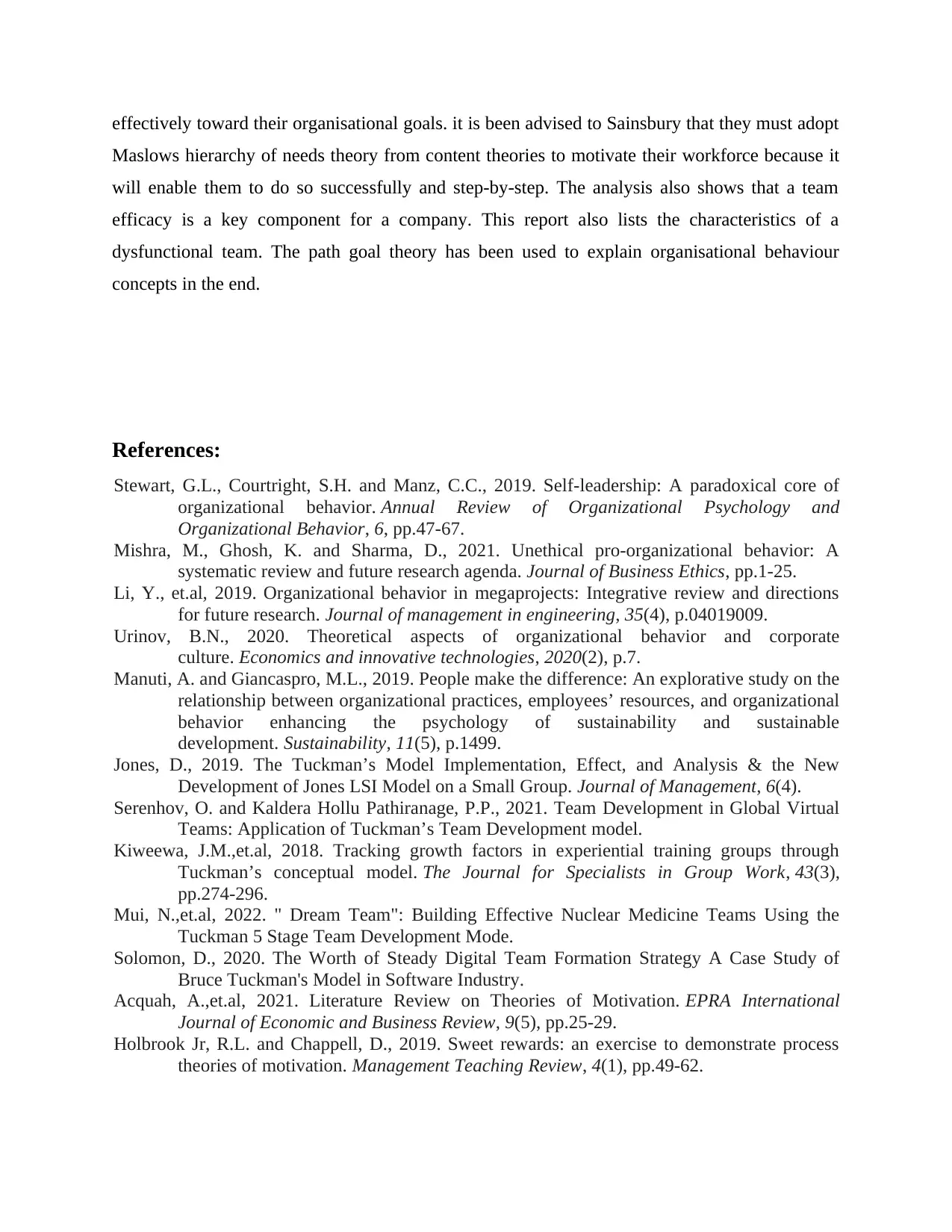
effectively toward their organisational goals. it is been advised to Sainsbury that they must adopt
Maslows hierarchy of needs theory from content theories to motivate their workforce because it
will enable them to do so successfully and step-by-step. The analysis also shows that a team
efficacy is a key component for a company. This report also lists the characteristics of a
dysfunctional team. The path goal theory has been used to explain organisational behaviour
concepts in the end.
References:
Stewart, G.L., Courtright, S.H. and Manz, C.C., 2019. Self-leadership: A paradoxical core of
organizational behavior. Annual Review of Organizational Psychology and
Organizational Behavior, 6, pp.47-67.
Mishra, M., Ghosh, K. and Sharma, D., 2021. Unethical pro-organizational behavior: A
systematic review and future research agenda. Journal of Business Ethics, pp.1-25.
Li, Y., et.al, 2019. Organizational behavior in megaprojects: Integrative review and directions
for future research. Journal of management in engineering, 35(4), p.04019009.
Urinov, B.N., 2020. Theoretical aspects of organizational behavior and corporate
culture. Economics and innovative technologies, 2020(2), p.7.
Manuti, A. and Giancaspro, M.L., 2019. People make the difference: An explorative study on the
relationship between organizational practices, employees’ resources, and organizational
behavior enhancing the psychology of sustainability and sustainable
development. Sustainability, 11(5), p.1499.
Jones, D., 2019. The Tuckman’s Model Implementation, Effect, and Analysis & the New
Development of Jones LSI Model on a Small Group. Journal of Management, 6(4).
Serenhov, O. and Kaldera Hollu Pathiranage, P.P., 2021. Team Development in Global Virtual
Teams: Application of Tuckman’s Team Development model.
Kiweewa, J.M.,et.al, 2018. Tracking growth factors in experiential training groups through
Tuckman’s conceptual model. The Journal for Specialists in Group Work, 43(3),
pp.274-296.
Mui, N.,et.al, 2022. " Dream Team": Building Effective Nuclear Medicine Teams Using the
Tuckman 5 Stage Team Development Mode.
Solomon, D., 2020. The Worth of Steady Digital Team Formation Strategy A Case Study of
Bruce Tuckman's Model in Software Industry.
Acquah, A.,et.al, 2021. Literature Review on Theories of Motivation. EPRA International
Journal of Economic and Business Review, 9(5), pp.25-29.
Holbrook Jr, R.L. and Chappell, D., 2019. Sweet rewards: an exercise to demonstrate process
theories of motivation. Management Teaching Review, 4(1), pp.49-62.
Maslows hierarchy of needs theory from content theories to motivate their workforce because it
will enable them to do so successfully and step-by-step. The analysis also shows that a team
efficacy is a key component for a company. This report also lists the characteristics of a
dysfunctional team. The path goal theory has been used to explain organisational behaviour
concepts in the end.
References:
Stewart, G.L., Courtright, S.H. and Manz, C.C., 2019. Self-leadership: A paradoxical core of
organizational behavior. Annual Review of Organizational Psychology and
Organizational Behavior, 6, pp.47-67.
Mishra, M., Ghosh, K. and Sharma, D., 2021. Unethical pro-organizational behavior: A
systematic review and future research agenda. Journal of Business Ethics, pp.1-25.
Li, Y., et.al, 2019. Organizational behavior in megaprojects: Integrative review and directions
for future research. Journal of management in engineering, 35(4), p.04019009.
Urinov, B.N., 2020. Theoretical aspects of organizational behavior and corporate
culture. Economics and innovative technologies, 2020(2), p.7.
Manuti, A. and Giancaspro, M.L., 2019. People make the difference: An explorative study on the
relationship between organizational practices, employees’ resources, and organizational
behavior enhancing the psychology of sustainability and sustainable
development. Sustainability, 11(5), p.1499.
Jones, D., 2019. The Tuckman’s Model Implementation, Effect, and Analysis & the New
Development of Jones LSI Model on a Small Group. Journal of Management, 6(4).
Serenhov, O. and Kaldera Hollu Pathiranage, P.P., 2021. Team Development in Global Virtual
Teams: Application of Tuckman’s Team Development model.
Kiweewa, J.M.,et.al, 2018. Tracking growth factors in experiential training groups through
Tuckman’s conceptual model. The Journal for Specialists in Group Work, 43(3),
pp.274-296.
Mui, N.,et.al, 2022. " Dream Team": Building Effective Nuclear Medicine Teams Using the
Tuckman 5 Stage Team Development Mode.
Solomon, D., 2020. The Worth of Steady Digital Team Formation Strategy A Case Study of
Bruce Tuckman's Model in Software Industry.
Acquah, A.,et.al, 2021. Literature Review on Theories of Motivation. EPRA International
Journal of Economic and Business Review, 9(5), pp.25-29.
Holbrook Jr, R.L. and Chappell, D., 2019. Sweet rewards: an exercise to demonstrate process
theories of motivation. Management Teaching Review, 4(1), pp.49-62.
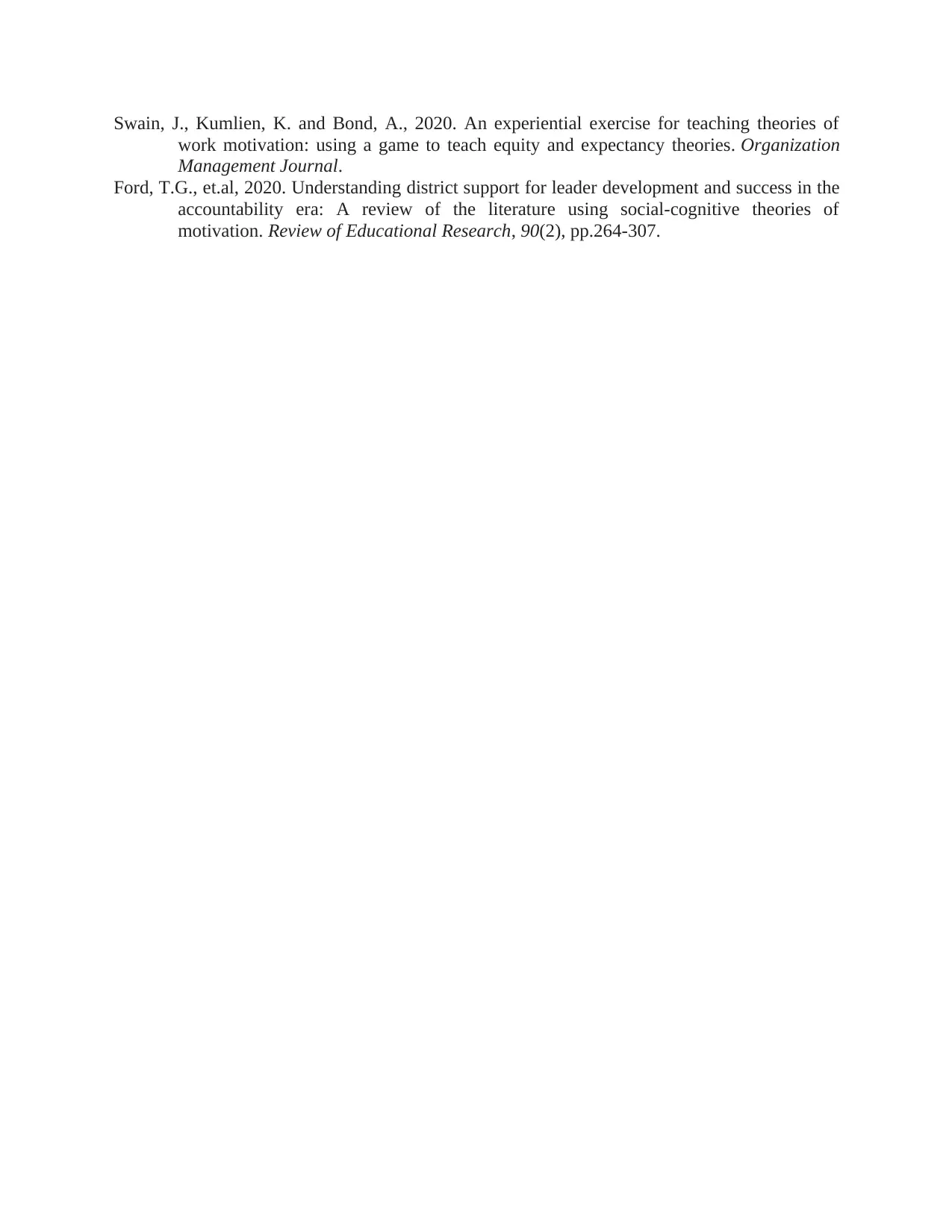
Swain, J., Kumlien, K. and Bond, A., 2020. An experiential exercise for teaching theories of
work motivation: using a game to teach equity and expectancy theories. Organization
Management Journal.
Ford, T.G., et.al, 2020. Understanding district support for leader development and success in the
accountability era: A review of the literature using social-cognitive theories of
motivation. Review of Educational Research, 90(2), pp.264-307.
work motivation: using a game to teach equity and expectancy theories. Organization
Management Journal.
Ford, T.G., et.al, 2020. Understanding district support for leader development and success in the
accountability era: A review of the literature using social-cognitive theories of
motivation. Review of Educational Research, 90(2), pp.264-307.
Paraphrase This Document
Need a fresh take? Get an instant paraphrase of this document with our AI Paraphraser

1 out of 14
Related Documents
Your All-in-One AI-Powered Toolkit for Academic Success.
+13062052269
info@desklib.com
Available 24*7 on WhatsApp / Email
![[object Object]](/_next/static/media/star-bottom.7253800d.svg)
Unlock your academic potential
© 2024 | Zucol Services PVT LTD | All rights reserved.





